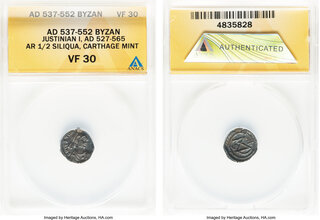| Heritage World Coin Auctions > Showcase Auction 61386 | Auction date: 21 April 2024 |
| Lot number: 24035 Price realized: 160 USD (Approx. 150 EUR) Note: Prices do not include buyer's fees. | Show similar lots on CoinArchives Find similar lots in upcoming auctions on |
| Lot description: Ancients Justinian I the Great (AD 527-565). AR half-siliqua (8mm, 9h). ANACS VF 30. Carthage, AD 537-552. D N IVSTINI-ANVS P P AC, pearl-diademed, draped, and cuirassed bust of Justinian I right, seen from front / MTDA monogram; cross above, S below; linear border, all within wreath. Sear 254 (siliqua). Rare issue. The monogram on the reverse (MTDA, with S below, and possibly N, I, or V) has been debated by numismatists for centuries, arguing amongst themselves about whether or not this unusually small denomination was in fact minted as an imitation by a barbarian monarch during Justinian's wars of reconquest in the late 530s. For further discussion on this monogram, see Philip Grierson's article "MATASUNTHA OR MASTINAS: A REATTRIBUTION" (119–30) in The Numismatic Chronicle and Journal of the Royal Numismatic Society 19, 1959. There are three potential candidates for the owner of the monogram. The first is Matasuntha, the Queen of the Ostrogoths. Matasuntha was a descendant of Theodoric, the first Ostrogothic King of Italy, but her husband King Vitiges was not--dynastic continuity makes the case for the queen's monogram (Grierson notes that this would be from the Latinized MATASVNDA). The second candidate would be Mastinas, mentioned by the Byzantine historian Procopius as the Berber client-king of post-Roman Mauretania who was able to evade conquest by the Vandals and later the Byzantines. This half-siliqua would be the only known coinage of the Berber client-kings: however, this could be because the kingdom was subordinate to the Byzantine Empire. Grierson interprets the final letter in the monogram as the Latin D, for dux--a common title for rulers in this region implying that the Berber client-kings identified themselves as a Roman military commanders subordinate to Constantinople. Perhaps the Berber client-king minted this pseudo-Byzantine coinage for use in trade with the nearby large cities of Carthage and Caesarea, which had been changing hands between the warring Vandals and Byzantines throughout this decade. The third candidate is of course Justinian himself, with the monogram representing DN IVSTINIANI and the M referring to some sort of denomination. The coin may simply be an issue from the mint of Carthage after the Byzantine reconquest of the city in 534. But the similarities with the smallness of the denominations used by the Ostrogoths, the uniqueness of the monogram, and in general the crudeness of the style all leave a confident identification as an open question. https://coins.ha.com/itm/ancients/byzantine/ancients-justinian-i-the-great-ad-527-565-ar-half-siliqua-8mm-9h-anacs-vf-30/a/61386-24035.s?type=DA-DMC-CoinArchives-WorldCoins-61386-04212024 HID02906262019 © 2024 Heritage Auctions | All Rights Reserved |  |



